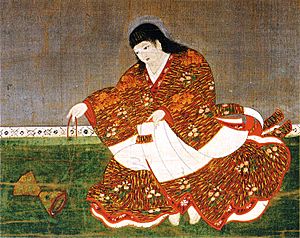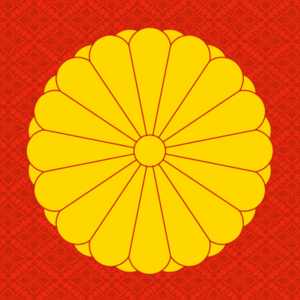Emperor Antoku facts for kids
Quick facts for kids Antoku |
|
|---|---|
| Emperor of Japan | |
 |
|
| Reign | 1180–1185 |
| Predecessor | Takakura |
| Successor | Go-Toba |
| Born | 22 December 1178 |
| Died | 25 April 1185 (aged 6) |
| Burial | Amida-ji no Misasagi (Shimonoseki) |
Emperor Antoku (安徳天皇, Antoku-tennō, 22 December 1178–25 April 1185) was the 81st emperor of Japan. He followed the traditional order of rulers. His time as emperor began in 1180 and ended in 1185. He was a very young emperor.
Contents
Becoming Emperor of Japan
Before he became emperor, his personal name was Tokohito-shinnō. He was the son of Emperor Takakura.
Antoku was named Crown Prince when he was only about one month old. He became emperor when he was just one year old.
- 1180: Emperor Takakura, Antoku's father, gave up his role as emperor. This is called abdicating. His infant son, Antoku, then became the new emperor. Soon after, Emperor Antoku officially took on the duties of the monarch.
- 1183: Emperor Go-Toba was named emperor by former-Emperor Go-Shirakawa. This meant that Japan had two emperors at the same time. Emperor Go-Toba was in Kyoto, while Emperor Antoku was moving south.
The Battle of Dan-no-ura
- 1185: A big naval battle happened between two powerful groups, the Taira clan and the Minamoto clan. This was the Battle of Dan-no-ura. It took place in the Shimonoseki Strait. This area is at the southern tip of the island of Honshu.
The Taira clan was defeated in this battle. Emperor Antoku died in the sea after his clan lost the fight.
A Sad End for the Child Emperor
The Battle of Dan-no-ura happened on April 24, 1185. It was a fight between the ruling Taira (also called Heike) and the Genji clan. Both groups wanted their leader to be the emperor. The Heike clan was greatly outnumbered and outsmarted.
Emperor Antoku's guardian was his grandmother, Lady Ni. When it became clear that the Heike had lost the battle, Lady Ni decided she would not be captured alive by the enemy.
The young emperor asked, "Where are you taking me?" His grandmother was crying. The child emperor said a Buddhist prayer. He then prayed to the east and to the west to say goodbye. Lady Ni took him in her arms. She said, "Our capital is in the depths of the ocean." Then, they both jumped into the sea and drowned.
Only 43 Heike clan members survived the battle. They ended up selling flowers to local fisher folk to live. Each year on April 24, a special ceremony is held. It takes place at a shrine near the battle scene. This ceremony remembers the child emperor's short life.
Emperor Antoku's Legacy
The story of Emperor Antoku and his mother's family is told in a famous Japanese tale. It is called The Tale of the Heike.
Amida-ji no misasagi is considered to be Antoku's symbolic tomb. It is near Akama Shrine at Shimonoseki. This area is in Yamaguchi Prefecture.
Related pages
| Preceded by Emperor Takakura |
Emperor or Tennō: Antoku 1180–1185 |
Succeeded by Emperor Go-Toba |
See also
 In Spanish: Antoku Tennō para niños
In Spanish: Antoku Tennō para niños


